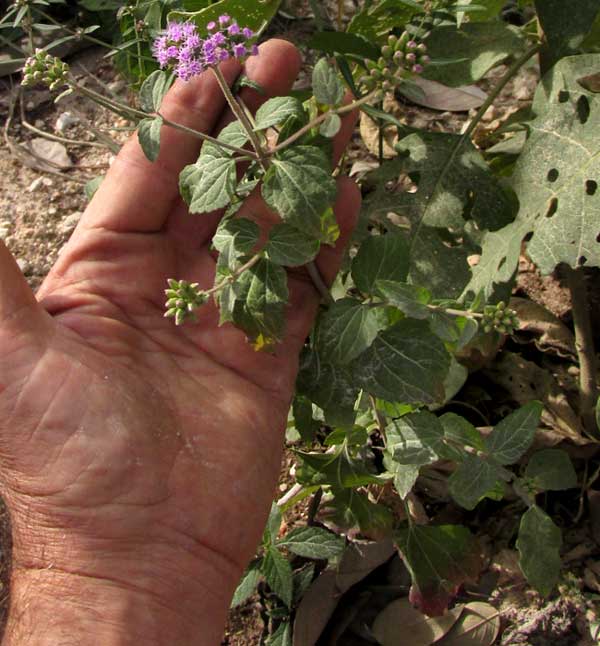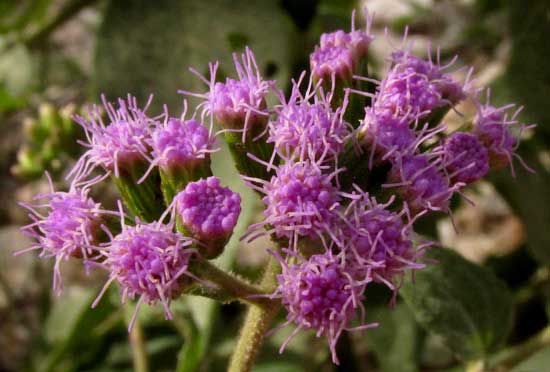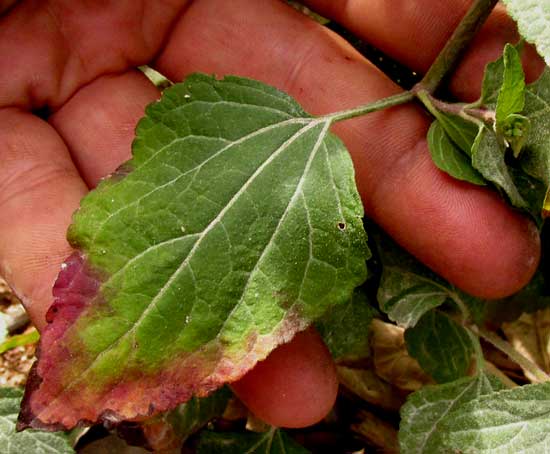Excerpts from Jim Conrad's
Naturalist Newsletter
from the March 6, 2016 Newsletter issued from Hacienda Chichen Resort beside Chichén Itzá Ruins; limestone bedrock; elevation ~39m (~128ft), N20.675°, W88.569°; central Yucatán state, MÉXICO
LAVENDER THOROUGHWORT

Nowadays the Newsletter is a little heavy on weeds because most decent native plants are hunkering down for the dry season. Weeds, however, confident in their strategy of opportunistically rooting wherever they can and broadcasting untold numbers of tiny seeds into all conceivable disturbed environments, sometimes turn up looking fresh as trilliums in spring. That was the case this week with a certain purple-flowered composite -- a member of the Composite/Sunflower/Aster Family -- along a dusty gravel road in such abused, dried-up dirt that it was surprising that anything could grow there, shown above.
The pretty flowering heads composed of disc flowers with slender style-branches extending far beyond the flowers' tops are shown below:

It's clear that these composite flowers belong to that subgroup of the Composite Family in which no petal-like ray flowers ornament the heads' perimeters. The disc flowers are held in tight clusters by a green, urn-like involucre composed of overlapping scales, or phyllaries, of different lengths, as shown below:

The plant's cypsela-type fruits will be topped with white parachutes of slender, white hairs, like aster fruits, as you can see below:

The leaves, two per node (opposite), bear shallowly scalloped, or "crenate," margins, as seen below:

Anyone familiar with the North's common wildflowers and garden ornamentals might think that this is a eupatorium or ageratum, and I was so sure of it myself that I began the ID process by looking at all eupatorium and ageratum species listed for the Yucatan. But none of those looked like our plant, and I had to "do the botany," which normally is hard with the Composite Family because the family is so huge, with so many look-alike species.
It took awhile to figure out that our dusty roadside plant was FLEISCHMANNIA PYCNOCEPHALA, the genus Fleischmannia being a genus not many northerners have heard about. In fact, some experts place the species in Eupatorium. Sometimes in English the plant is called the Lavender Thoroughwort, thoroughworts usually thought of as being eupatoriums.
Fleischmannia pycnocephala occurs commonly in various kinds of disturbed, weedy soils, from roadsides and pastures to coffee plantations, as well as in both dry and humid forests, all through Mexico and south through most of Central America.
Medicinally, it's mainly used during childbirth and for stomach ache.